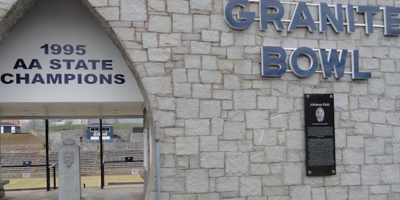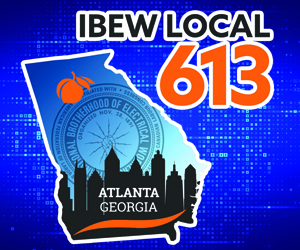
High School Football games have been played in Georgia for more than a century and the state’s proud gridiron history over the decades has been shaped by the electric game day atmospheres provided across its landscape. While every stadium has its own unique history, there are a group of stadiums that have become especially intimidating places for opposing teams to travel to. Here, I will examine which of these stadiums has not only home field advantage, but also unique qualities that make them a memorable and difficult place to play.
1. Granite Bowl in Elberton: The state’s most unique stadium would have to be the Granite Bowl in Elberton, Ga. that is home to the Elbert County Blue Devils. The aptly named stadium was built in 1962 by using 100,000 tons of local granite. Its locally-inspired construction materials has made it a must-see tourist attraction for those visiting the area and during football season the beloved stadium cheers on the 1995-state champion Blue Devils. Legendary head coach T. McFerrin led the program from 1990-1996 and won 75 football games in those seven seasons. Now, his former quarterback Shannon Jarvis has stepped into serve as his alma mater’s head coach. Jarvis was formerly the head coach at Mill Creek where he launched the program from its inception and transformed it into one of the most consistent football teams in the state’s highest classification. With Jarvis back on the sidelines in Elberton, expect the Granite Bowl to have even more buzz on Friday nights in the Fall.
2. Bazemore-Hyder Stadium in Valdosta: Bazemore-Hyder Stadium was originally built in 1922 and goes by the nickname “Death Valley”. The stadium is just two seasons away from celebrating its 100th. The Wildcats have more all-time wins than any other high school football program in the nation and many of the school’s 24 state championships were clinched on the program’s home turf over the years. When the renovations were completed before the start of the 2004 fall season, the capacity increased to 11,249 which includes 7,749 reserved seats. As part of the renovations, the natural grass field was replaced with a synthetic Sprinturf field. A Valdosta Wildcat Museum, featuring memorabilia and trophies from the programs storied past was built. Next to the museum is the memorial courtyard containing personalized bricks including names of past wildcat players, and monuments to Valdosta High coaches Wright Bazemore, Nick Hyder and former superintendent A.G. Cleveland.
3. Martin Stadium in Valdosta: Martin Stadium is located on campus of Lowndes High School and is commonly known as “The Concrete Palace”. This venue is capable of seating roughly 12,000 and has become as feared of a venue as any in the state. The Vikings have put together three separate home winning streaks of more than 20 games since 1996 and three State Title game victories (2007 North Gwinnett, 34-6; 2005 Brookwood, 49-7; and 1999 Brunswick, 17-0). The Vikings also won the State Championship at home in 1980 with a 28-12 triumph over Griffin. The Vikings have a total home record of 136-22 since the start of 1995, including a 23-3 playoffs record.
4. Big Orange Jungle in Lilburn: Parkview’s Big Orange Jungle is one of the toughest places for visiting opponents to visit and has given the Panthers home field success against other Gwinnett powerhouses and visiting South Georgia powerhouses over the years. Starting in 2000, Parkview strung together three-straight perfect 15-0 seasons and the program hoisted its fourth state title in a 6-year span following its 2002 triumph. Last year’s Panthers were 7-0 at home until eventual state champion Marietta topped them 42-31 in the semifinals.
5. Grisham Stadium in Carrollton: Carrollton’s Grisham Stadium is the Trojans’ massive home field that has tradition, technology and a state-of-the-art track and field complex among its many impressive features. Carrollton is the 7th all-time winningest program in the state of Georgia with 685 all-time victories and opponents visiting Grisham Stadium are reminded of the Trojans historic success. A new grand entrance was incorporated in 2008-2009 to include a brick memorial walkway and a 12-foot-tall (3.7 m) bronze Trojan monument also greets fans upon entering the updated stadium. These additions have been linked with the existing “TrojanTron” and Matrix Boards, as well as the home fieldhouse which houses the Trojan Hall of Fame.
6. Barron Stadium in Rome: Historic Barron Stadium is a 6,500-seat football field and track & field stadium in Rome, Georgia. Barron hosted football state championship wins for local East Rome High School in 1977 and 1978, and for West Rome High School in 1983 and 1985. The last crosstown rivalry football game between the schools was played at Barron in 1991 before they were consolidated into one high school (The Rome Wolves). State football championship games were also held at Barron Stadium in 1953, 1954, 1969, 1971, 1972, and 1974. The stadium also began hosting Shorter College football in 2005, the program’s inaugural season. Currently, the Rome Wolves have experienced tremendous success at the venue and the program has accumulated 40 wins and a pair of state titles over the past four seasons. New additions like a state-of-the-art videoboard have blended the past with the present and created a venue that represents the proud tradition of Georgia High School Football.
7. Cantrell Stadium in Powder Springs: McEachern’s Cantrell Stadium opened in 1984 and can hold up to 12,000 fans. In addition to its massive capacity, the stadium also features the largest videoboard in the state and a massive 23-foot fiberglass Indian in the endzone. McEachern has reached 11-straight postseasons and has advanced past the first round of the state playoffs on nine occasions during the same span. Last year’s squad posted a perfect regular season and was 12-0 before a 32-13 home loss to North Gwinnett in the quarterfinals.
8. The Brickyard in Thomson: Thomson has the 10th-most victories in state history at 654 and has enjoyed much of its success at its historic home stadium. “The Brickyard” first opened in 1941 and its construction gives it its unique quality. After a lightning-caused fire destroyed the school in 1937, the bricks were utilized to construct the stadium. Thomson has won 24 region titles and five state titles over the years and carries a 10-year playoff streak into the 2020 season.
9. Weinman Stadium in Cartersville: Cartersville has not lost a region game since the 2011 season and has posted a 79-1 record in the past eight regular seasons in addition to a superb 103-7 overall record—making them the most successful team over the same span. Over the stadium’s 64-year history, the stadium has hosted two state championship games (Cartersville won both).
10. Chris Gilman Stadium: Camden County’s Chris Gilman Stadium holds 10,000 fans—making it one of the largest high school football stadiums in the state. The Wildcats program is well-known for its massive support and the school holds the state-record for the longest regular-season winning streak at 58 games—although Cartersville has matched them at 58 games following last year’s season and is a win away from exclusively holding the record. Camden County won region champions in 1975, 1979, 1987, 1992, 1993, 1994, 1996, and every year from 2001 to 2013. The Wildcat football team has also won three AAAAA State Championships, the first in 2003, then back-to-back state titles in 2008 and 2009.







































